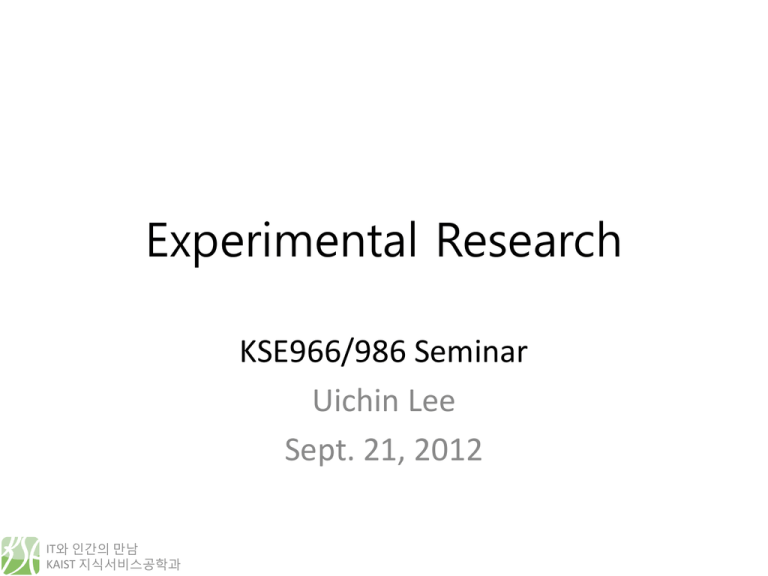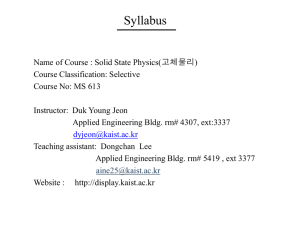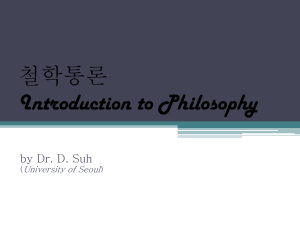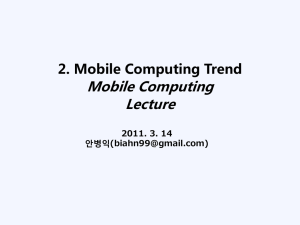Research Methods in Knowledge Service Engineering
advertisement

Experimental Research KSE966/986 Seminar Uichin Lee Sept. 21, 2012 IT와 인간의 만남 KAIST 지식서비스공학과 Overview • • • • • Types of behavioral research Research hypotheses Basics of experimental research Significance tests Limitations of experimental research IT와 인간의 만남 KAIST 지식서비스공학과 Types of behavioral research • Descriptive investigations focus on constructing an accurate description of what is happening. • Relational investigations enable the researcher to identify relations between multiple factors. However, relational studies can rarely determine the causal relationship between multiple factors. • Experimental research allows the establishment of causal relationship. IT와 인간의 만남 KAIST 지식서비스공학과 Types of behavioral research IT와 인간의 만남 KAIST 지식서비스공학과 Research hypotheses • An experiment normally starts with a research hypothesis. • A hypothesis is a precise problem statement that can be directly tested through an empirical investigation. • Compared with a theory, a hypothesis is a smaller, more focused statement that can be examined by a single experiment IT와 인간의 만남 KAIST 지식서비스공학과 Types of hypotheses • Null hypothesis: typically states that there is no difference between experimental treatments. • Alternative hypothesis: a statement that is mutually exclusive with the null hypothesis. • The goal of an experiment is to find statistical evidence to refute or nullify the null hypothesis in order to support the alternative hypothesis. • A hypothesis should specify the independent variables and dependent variables. IT와 인간의 만남 KAIST 지식서비스공학과 Research hypotheses • Independent variables (IV) refer to the factors that the researchers are interested in studying or the possible “cause” of the change in the dependent variable. – IV is independent of a participant’s behavior. – IV is usually the treatments or conditions that the researchers can control. • Dependent variables (DV) refer to the outcome or effect that the researchers are interested in. – DV is dependent on a participant’s behavior or the changes in the IVs – DV is usually the outcomes that the researchers need to measure. IT와 인간의 만남 KAIST 지식서비스공학과 Typical independent variables in HCI • Those that relate to technology – Types of technology or device – Types of design • Those that relate to users: age, gender, computer experience, professional domain, education, culture, motivation, mood, and disabilities • Those that relate to context of use: – Physical status – User status – Social status IT와 인간의 만남 KAIST 지식서비스공학과 Typical dependent variables in HCI • Efficiency: – e.g., task completion time, speed • Accuracy: – e.g., error rate • Subjective satisfaction: – e.g., Likert scale ratings • Ease of learning and retention rate • Physical or cognitive demand – e.g., NASA task load index IT와 인간의 만남 KAIST 지식서비스공학과 Components of experiment • Treatments, or conditions: the different techniques, devices, or procedures that we want to compare • Units: the objects to which we apply the experiment treatments. In HCI research, the units are normally human subjects with specific characteristics, such as gender, age, or computing experience • Assignment method: the way in which the experimental units are assigned different treatments. IT와 인간의 만남 KAIST 지식서비스공학과 Randomization • Randomization: the random assignment of treatments to the experimental units or participants • In a totally randomized experiment, no one, including the investigators themselves, is able to predict the condition to which a participant is going to be assigned • Methods of randomization – Preliminary methods – Random table – Software driven randomization IT와 인간의 만남 KAIST 지식서비스공학과 Significance tests • Why do we need significance tests? – When the values of the members of the comparison groups are all known, you can directly compare them and draw a conclusion. No significance test is needed since there is no uncertainty involved. – When the population is large, we can only sample a subgroup of people from the entire population. – Significance tests allow us to determine how confident we are that the results observed from the sampling population can be generalized to the entire population. IT와 인간의 만남 KAIST 지식서비스공학과 Type I and Type II errors • All significance tests are subject to the risk of Type I and Type II errors. • A Type I error (also called an α error or a “false positive”) refers to the mistake of rejecting the null hypothesis when it is true and should not be rejected. • A Type II error (also called a β error or a “false negative”) refers to the mistake of not rejecting the null hypothesis when it is false and should be rejected. IT와 인간의 만남 KAIST 지식서비스공학과 Type I and Type II errors • H0: The defendant is innocent • H1: The defendant is guilty 진실 H0 True 무죄인 배심원 판결 IT와 인간의 만남 KAIST 지식서비스공학과 Reject H0 유죄 Fail to reject H0: 무죄 H0 False 죄인 Type I Error (False Positive) Type II Error (False Negative) Type I and Type II errors • H0: There is no difference between the ease of ATMs with touchscreens and ATMs w/ buttons • H1: ATMs with touchscreens are easier to use than ATMs with buttons 진실 H0 True No difference 실험결과 Reject H0 Touchscreen is easier IT와 인간의 만남 KAIST 지식서비스공학과 Fail to reject H0: No difference H0 False Touchscreen is easier Type I Error (False Positive) Type II Error (False Negative) Type I and Type II errors • It is generally believed that Type I errors are worse than Type II errors. • Statisticians call Type I errors a mistake that involves “gullibility”. – A Type I error may result in a condition worse than the current state. • Type II errors are mistakes that involve “blindness” – A Type II error can cost the opportunity to improve the current state. IT와 인간의 만남 KAIST 지식서비스공학과 Controlling risks of errors • In statistics, the probability of making a Type I error is called alpha (or significance level, p value). • The probability of making a Type II error is called beta. • The statistical power of a test, defined as 1−β, refers to the probability of successfully rejecting a null hypothesis when it is false and should be rejected IT와 인간의 만남 KAIST 지식서비스공학과 Controlling risks of errors • Alpha and beta are interrelated. Under the same conditions, decreasing alpha reduces the chance of making Type I errors but increases the chance of making Type II errors. • In experimental research, it is generally believed that Type I errors are worse than Type II errors. • So a very low p value (0.05) is widely adopted to control the occurrence of Type I errors. IT와 인간의 만남 KAIST 지식서비스공학과 Limitations of Experimental Research • Experimental research requires well-defined, testable hypotheses that consist of a limited number of dependent and independent variables. • Experimental research requires strict control of factors that may influence the dependent variables. • Lab-based experiments may not be a good representation of users’ typical interaction behavior. IT와 인간의 만남 KAIST 지식서비스공학과 End-of-chapter • Summary • Discussion questions • Research design exercise IT와 인간의 만남 KAIST 지식서비스공학과






